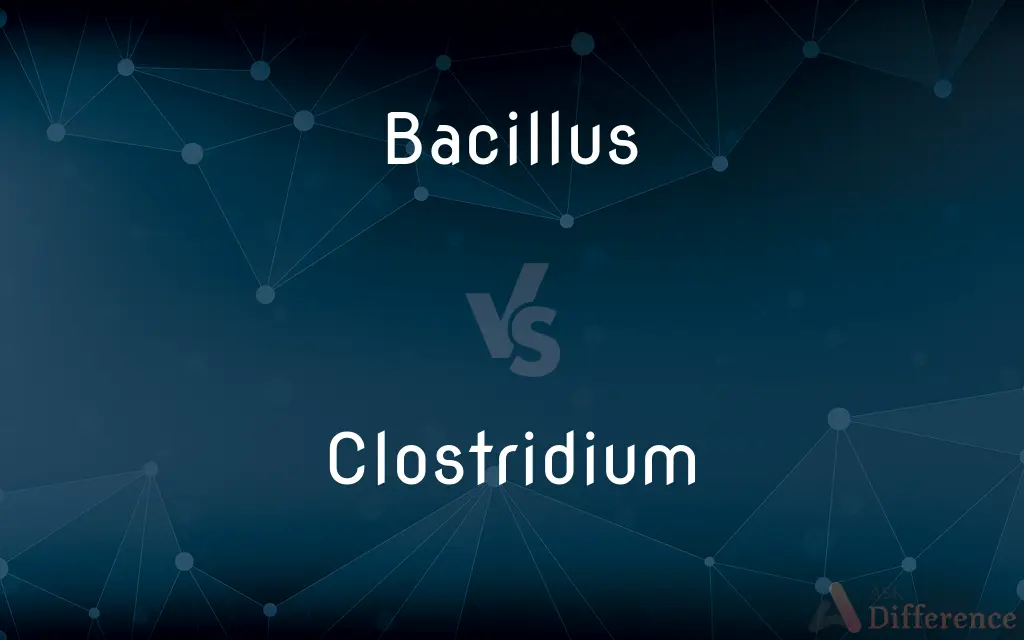Bacillus vs. Clostridium — What's the Difference?
Edited by Tayyaba Rehman — By Maham Liaqat — Updated on April 17, 2024
Bacillus and Clostridium are both genera of bacteria, but Bacillus are aerobic, forming endospores in favorable conditions, while Clostridium are anaerobic, thriving in low or no oxygen environments.

Difference Between Bacillus and Clostridium
Table of Contents
ADVERTISEMENT
Key Differences
Bacillus bacteria are known for their ability to thrive in aerobic environments (presence of oxygen), forming protective endospores that allow them to survive in harsh conditions. Conversely, Clostridium bacteria are obligate anaerobes, meaning they can only survive in environments with little to no oxygen, and also produce endospores under stress.
While both Bacillus and Clostridium can form endospores to withstand unfavorable conditions, the spores of Bacillus are generally more resistant to heat and chemicals compared to those of Clostridium, which are more sensitive but can survive in more anaerobic conditions.
In terms of metabolism, Bacillus species are versatile, capable of using oxygen for respiration or switching to fermentation if oxygen is scarce. On the other hand, Clostridium species are primarily fermenters, relying on substrate-level phosphorylation to generate energy, which restricts them to more specific environments.
The ecological roles of Bacillus include decomposing organic materials and facilitating nutrient cycling, making them important in various environments. In contrast, Clostridium plays a crucial role in producing butyric acid, acetone, and alcohol, which are significant in both natural processes and industrial applications.
Medical relevance also differs; Bacillus species are less frequently pathogenic, with some strains beneficial as probiotics. Clostridium includes several pathogenic strains, such as those causing tetanus, botulism, and pseudomembranous colitis, posing significant health risks.
ADVERTISEMENT
Comparison Chart
Oxygen Requirement
Aerobic or facultatively anaerobic.
Obligate anaerobe.
Endospore Formation
Forms resistant endospores in favorable conditions.
Forms endospores primarily in response to stress.
Metabolism
Can utilize oxygen for respiration; versatile.
Primarily uses fermentation; energy from substrates.
Ecological Role
Decomposition, nutrient cycling.
Produces butyric acid, acetone, important in industry.
Pathogenicity
Generally non-pathogenic, some are probiotics.
Includes several highly pathogenic strains.
Compare with Definitions
Bacillus
Aerobic bacteria.
Bacillus species need oxygen to thrive, making them common in soil and water exposed to air.
Clostridium
Anaerobic bacteria.
Clostridium species require environments devoid of oxygen to grow, such as deep soil layers.
Bacillus
Endospore producer.
Bacillus can form endospores that survive extreme conditions like heat and drought.
Clostridium
Disease causation.
Clostridium tetani is the causative agent of tetanus, a serious neurological disease.
Bacillus
Nutrient cycling.
Bacillus helps break down complex organic compounds, releasing nutrients back into the environment.
Clostridium
Biotechnological applications.
Clostridium acetobutylicum is utilized in the production of biofuels.
Bacillus
Industrial enzyme production.
Bacillus is used in the production of enzymes for detergents and other applications.
Clostridium
Butyric acid production.
Clostridium butyricum produces butyric acid, which is crucial in various biochemical processes.
Bacillus
Probiotic use.
Bacillus coagulans is often used as a probiotic to aid digestion.
Clostridium
Endospore sensitivity.
Clostridium spores, while resistant, are less tolerant to heat compared to Bacillus spores.
Bacillus
Bacillus (Latin "stick") is a genus of Gram-positive, rod-shaped bacteria, a member of the phylum Firmicutes, with 266 named species. The term is also used to describe the shape (rod) of certain bacteria; and the plural Bacilli is the name of the class of bacteria to which this genus belongs.
Clostridium
Clostridium is a genus of Gram-positive bacteria. This genus includes several significant human pathogens, including the causative agents of botulism and tetanus.
Bacillus
Any of various bacteria, especially a rod-shaped bacterium.
Clostridium
Any of various rod-shaped, spore-forming, chiefly anaerobic bacteria of the genus Clostridium, such as certain nitrogen-fixing species found in soil and those causing botulism and tetanus.
Bacillus
Any of various rod-shaped, spore-forming, aerobic bacteria of the genus Bacillus that often occur in chains and include B. anthracis, the causative agent of anthrax.
Clostridium
Any of several mostly anaerobic gram-positive bacteria, of the genus Clostridium, that are present in the soil and in the intestines of humans and animals and are capable of forming spores
Bacillus
Any of various rod-shaped, spore-forming aerobic bacteria in the genus Bacillus, some of which cause disease.
Clostridium
Spindle-shaped bacterial cell esp. one swollen at the center by an endospore.
Bacillus
Any bacilliform (rod-shaped) bacterium.
Clostridium
A genus of anaerobic, spore-forming motile bacteria of the family Bacillaceae, including several pathogenic species, such as the causative agents of gas gangrene (Clostridium perfringens), botulism (Clostridium botulinum), and tetanus (Clostridium tetani).
Bacillus
Something which spreads like bacterial infection.
Clostridium
Spindle-shaped bacterial cell especially one swollen at the center by an endospore
Bacillus
A variety of bacterium; a microscopic, rod-shaped vegetable organism.
Bacillus
Aerobic rod-shaped spore-producing bacterium; often occurring in chainlike formations; found primarily in soil
Common Curiosities
Can both Bacillus and Clostridium form spores?
Yes, both can form endospores, but the triggers and resistance levels of these spores differ between the genera.
How do Bacillus and Clostridium contribute to their environments?
Bacillus plays a role in decomposing organic materials and nutrient cycling, whereas Clostridium is crucial in the production of important biochemicals and industrial substances.
What are some practical applications of Bacillus in industry?
Bacillus is extensively used in biotechnology for the production of enzymes, antibiotics, and as probiotics.
What distinguishes Bacillus from Clostridium in terms of oxygen needs?
Bacillus can survive in both oxygen-rich and oxygen-poor environments, making them more adaptable, while Clostridium can only thrive in low or no oxygen conditions.
What adaptations allow Bacillus and Clostridium to survive harsh conditions?
Both genera produce endospores that can withstand extreme environmental stress, ensuring their survival and persistence.
Why are Clostridium species often more concerning in medical settings?
Clostridium includes several species that are pathogenic to humans, causing severe and sometimes life-threatening diseases.
Are all Clostridium species harmful?
Not all; some Clostridium species are used beneficially in biotechnology and production processes, although the genus includes notable pathogens.
How do the metabolic pathways of Bacillus and Clostridium differ?
Bacillus can use oxygen for metabolism or ferment if oxygen is scarce, offering metabolic flexibility, whereas Clostridium relies primarily on fermentation.
What makes Bacillus a good candidate for probiotic formulations?
Certain Bacillus strains are non-pathogenic and can survive the gastrointestinal tract, supporting digestive health.
What are the implications of Clostridium's anaerobic lifestyle for its ecological niche?
Clostridium's anaerobic nature restricts it to environments that are devoid of oxygen, influencing its distribution and ecological role.
Share Your Discovery

Previous Comparison
Action vs. Scheme
Next Comparison
Square vs. TetragonAuthor Spotlight
Written by
Maham LiaqatEdited by
Tayyaba RehmanTayyaba Rehman is a distinguished writer, currently serving as a primary contributor to askdifference.com. As a researcher in semantics and etymology, Tayyaba's passion for the complexity of languages and their distinctions has found a perfect home on the platform. Tayyaba delves into the intricacies of language, distinguishing between commonly confused words and phrases, thereby providing clarity for readers worldwide.














































